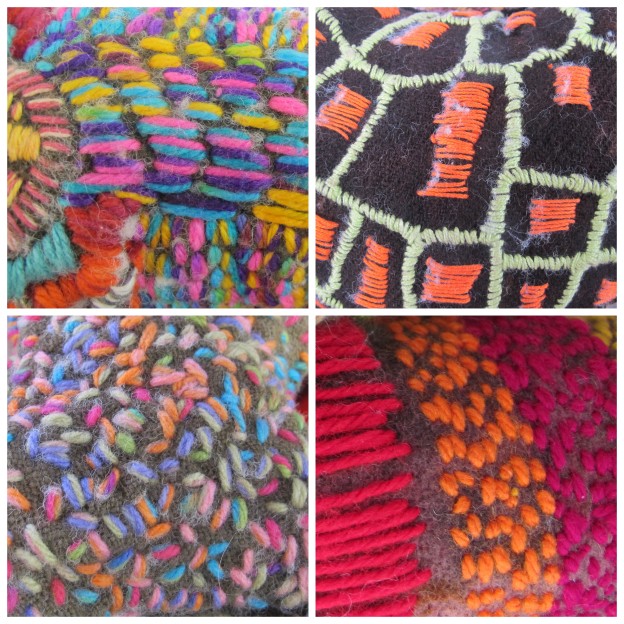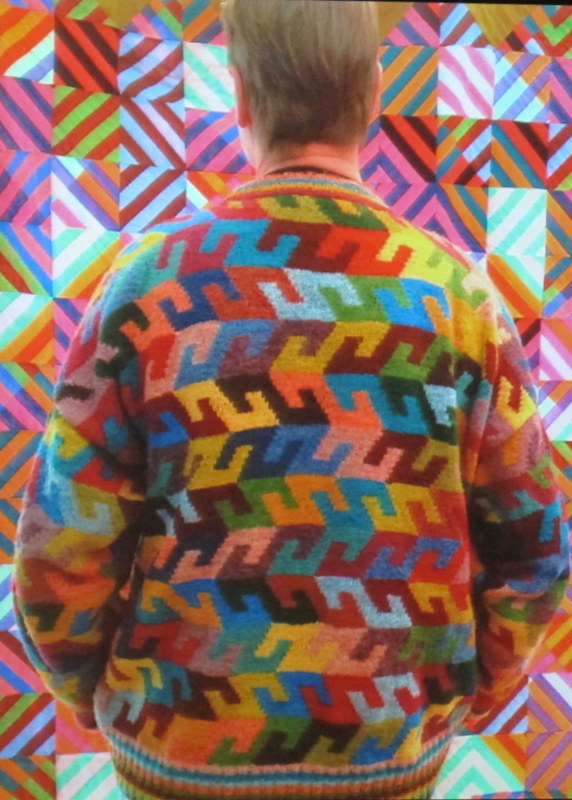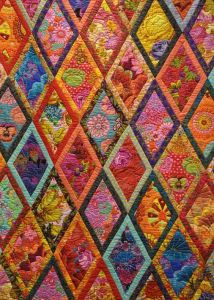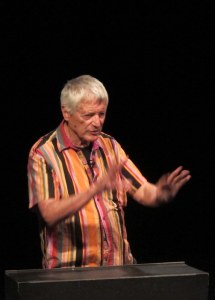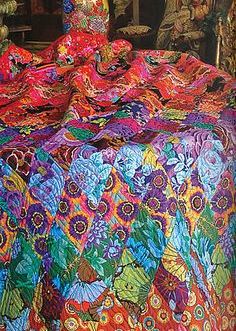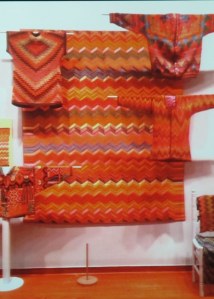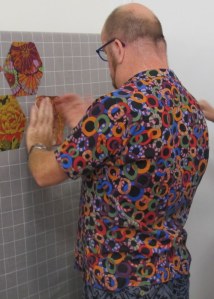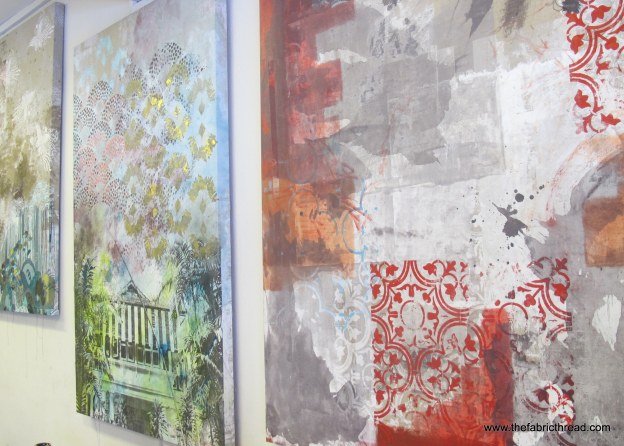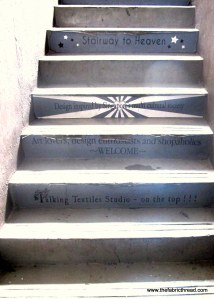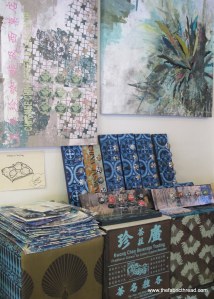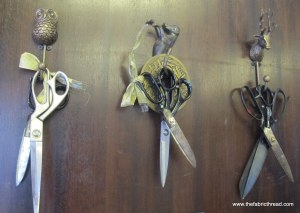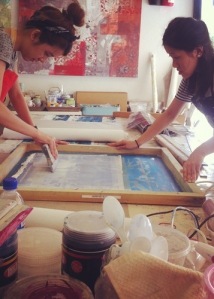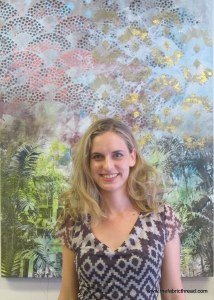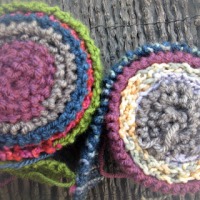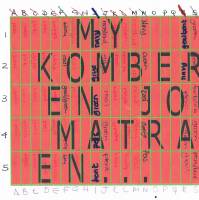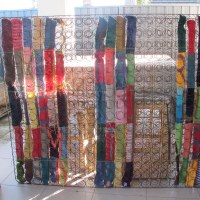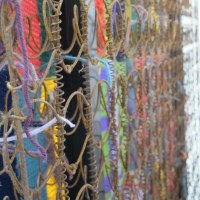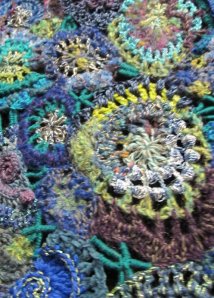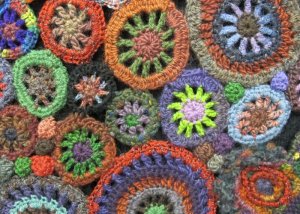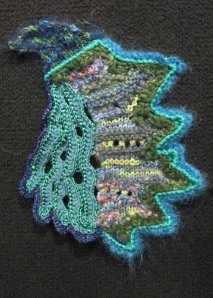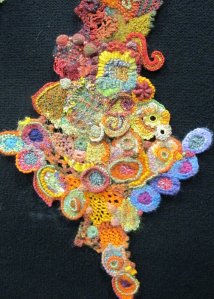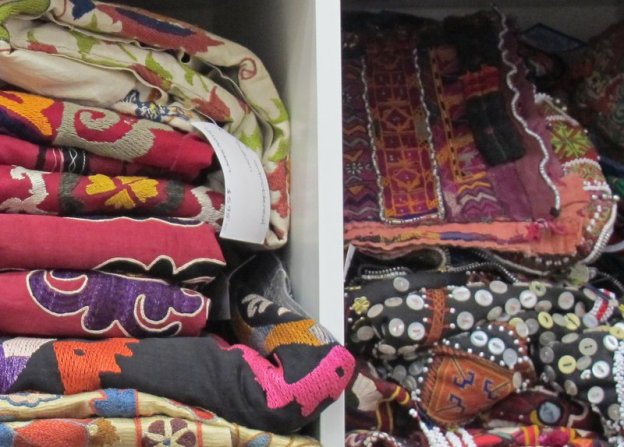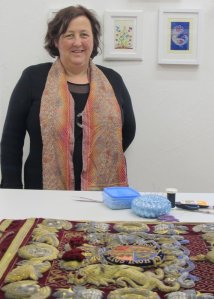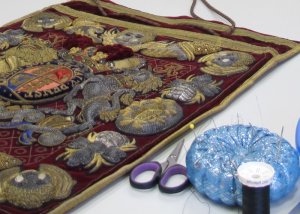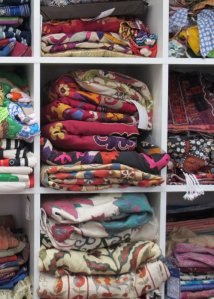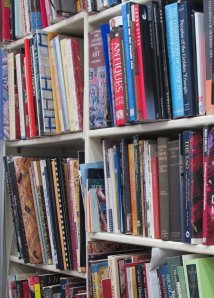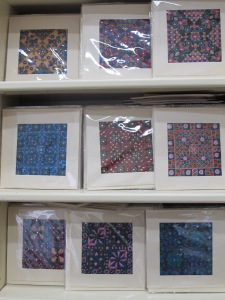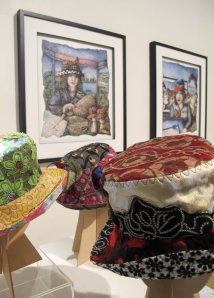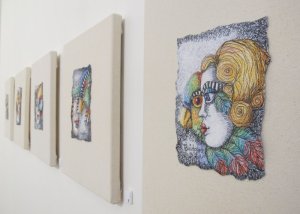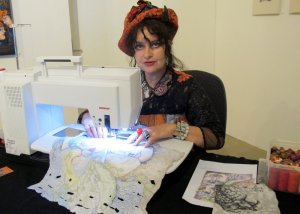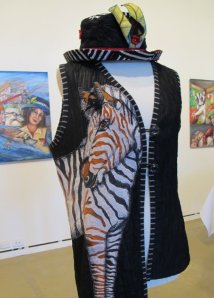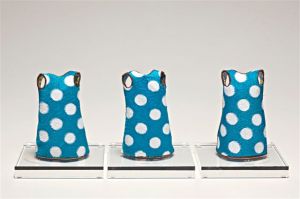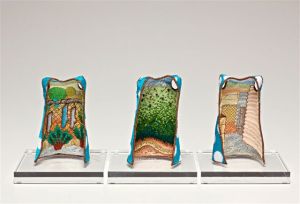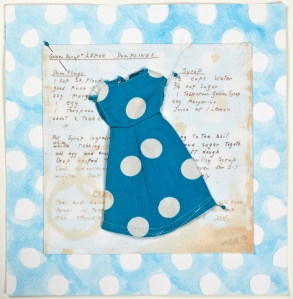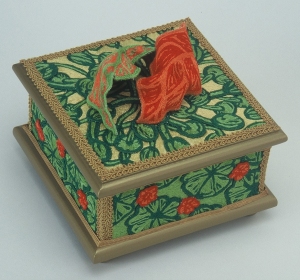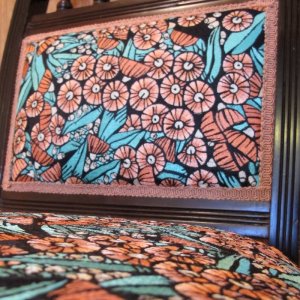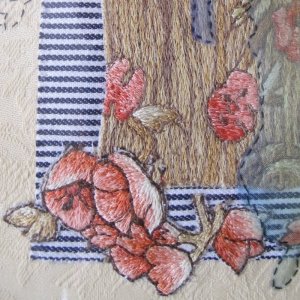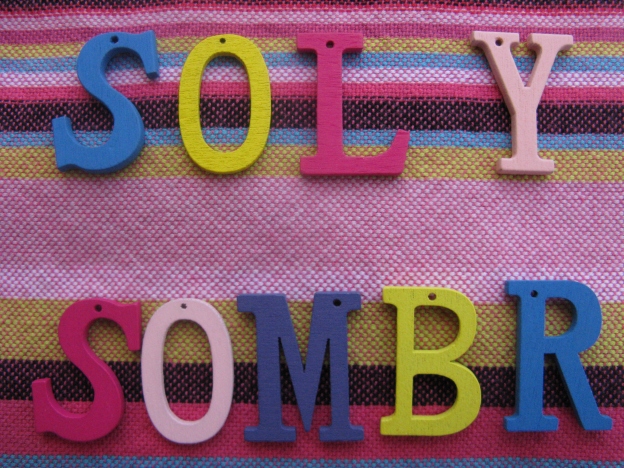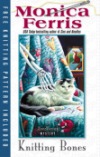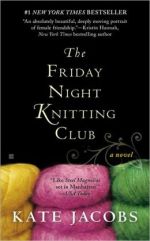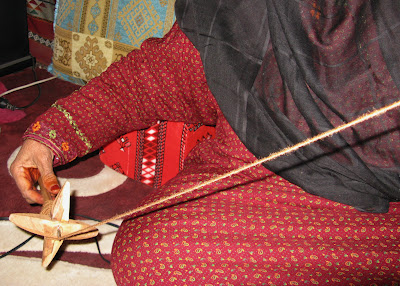It is a windswept Saturday morning.
The Weather Bureau warned about cold winds blowing across the Gulf from the snow covered mountains of Iran. As the sand billows across the road and the driver cling to the wheel, I peer at the desolate and featureless desert landscape passing by the car window. “Who would want to live here?” I wonder.
I am on my way to Sila, a small village in the Northern part of the Emirate of Abu Dhabi; about 3 hours drive from the city and the last outpost before the border with Saudi Arabia. There is nothing here. Not even dunes. Just flat stretches of coarse, colourless sand as far as the eye can see.
I am accompanied by Leila Ben-Gacem, the project leader of the Sougha Project. We are on our way to visit Bhkita and Hamama, a Bedouin mother-and-daughter team who are part of Leila’s team of traditional weavers. They graciously opened their home to me to introduce me to the art of Sadou weaving.
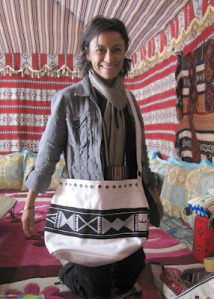
Leila showing off one of Bhkita’s bags
Sadou is a traditional Bedouin form of weaving.
The women, working on ground looms, produce long narrow strips of patterned textile using yarn spun from camel and goat hair or sheep wool. These textile strips are then sewn together to make the walls of their traditional tents, camel bags and other utilitarian items.
These days, however, things look a bit different. With the rapid economic development of the United Arab Emirates, the Bedouin’s nomadic lifestyle has all but disappeared. The government has built houses for the nomads and settled them in formal villages where they have learned to live with electricity and other modern conveniences. The children go to school and move on to careers in the city. It is a wonderful privilege and opportunity their parents never had, but it means ancient Bedouin traditions are fast dying out.
One of these traditions is Sadou weaving. A craft which were passed on from mother to daughter and which were done in communal settings where folklore and female wisdom could be passed down from one generation to the next. Now only the older women still know how to do it and their daughters are in general not interested.
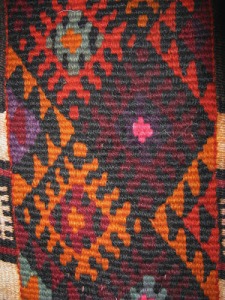
A close-up of the tent-wall
Enters Leila and her Sougha Project.
It is an initiative launched by the Khalifa Fund aimed at preserving local heritage by developing traditional artisans. The women are taught how to adapt their products to the current market and trained to create opportunities for themselves.
Leila is a petite Tunisian woman with short dark hair and a big smile. What she lacks in stature she more than makes up for in energy and enthusiasm. She lives for this project and these Bedouin women. I’ve met Leila last summer. She showed me the products for sale at their kiosk in Abu Dhabi, told me about the Sougha project and invited me to visit the Liwa Date Festival where I would see the ladies working.
I visited the date festival later in July 2011 where I observed some of the ladies do their telli embroidery (that’s a different story…) and weave palm fronds into baskets, mats and other household items. The weavers were displaying their wares but obviously not doing any weaving on the show. I bought a small woven carpet from Bhkita’s stall. Her work mesmerised me. It was obvious that here was a very talented woman. Her designs and quality of craftsmanship were a step above the rest. The language barrier (my Arabic is as limited as her English) meant that it was not possible to ask her about her work but I wanted to know more. Leila obliged and organised for me to visit her home. And here we are…
As we arrive at Bkhita’s house we are welcomed by her daughter Hamama
and invited into a Bedouin tent erected right next to their brick and mortar house. The inside walls of the tent are made from traditional woven wall panels, the floor is covered in carpets. Big pillows are set around the edge of the tent as floor seating. A low wooden table is laid out with Arabic coffee, dates, fruit and pastries. The only reminder that we are in the 21st century is the big TV screen against the one wall.
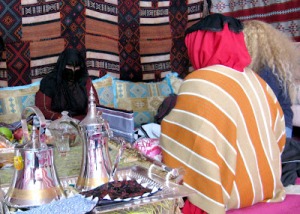
Enjoying coffee and treats with Bhkita and Hamama
As soon as we are seated on the carpet, Hamama serves us small cups of coffee and dates. It is obvious that both women are delighted to see Leila. They chatter non-stop updating Leila on all the latest gossip in town. Leila tells me they are very honoured to share their craft with me and I must please show the world the beautiful things they make. I am happy to oblige.
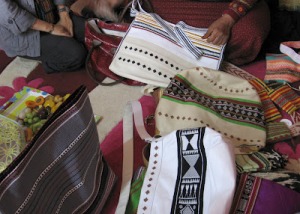
Admiring Bhkita’s work
Bhkita shows me some of her finished work
in between telling me about her children and grandchildren (Leila has to translate very fast, as Bhkita never stops talking!), . She uses the woven cloth to make bags in different sizes – from handbags, laptop bags, pencil cases, makeup bags and more – to coasters, table runners and other household goods. She not only weaves but also sews the bags all by herself. She buys camel leather from the tannery in Al Ain (another Khalifa Fund initiative), the cotton she uses for the lining as well as the thread and fasteners she buys in Abu Dhabi or Doha. She uses a modern, electricity-driven sewing machine.
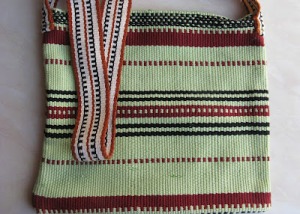
A Sadou laptop bag
Bhkita’s age is a mystery but I guess her to be in her late sixties. She never went to school. Her childhood was spent roaming the desert with her family. According to her daughter, she attended an ‘illiteracy eradication programme’ provided by the government. She can write her name and she ‘knows numbers’. But don’t be fooled – this is a very smart, intelligent woman. And immensely talented. The woven strips she makes as inserts to her leather bags are narrower than what she would normally make for a tent wall.
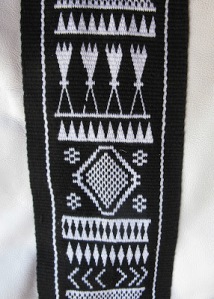
Bhkita’s latest design. She is very proud of this one.
Can you see all the counting going on here?
The patterns are intricate and delicate.
The colour combinations are inspirational. The quality of craftsmanship is exceptional. Bhkita is very proud of her work and her designs. She makes sure I notice that there are no flaws in the textile or pattern. She doesn’t make mistakes.
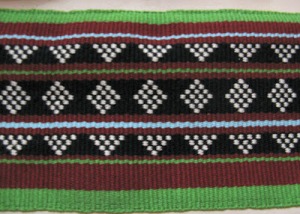
Bhkita has an amazing instinct for colour
The ‘workshop’ is in the house.
When we had enough (too much) to eat and drink it was time for her to show me how she works. As we enter the front door, the floor loom is the first thing I see. It is set out on the carpet in the reception area of her house. In a traditional setting, the loom would be made of split palm tree trunks held together with palm fibre twine. The single heddle would be held in place with wooden stakes. The ‘modern’ version I see in front of me is made of galvanised pipes held together with nylon rope. The piece of pipe holding the string heddles is kept in place with bricks.
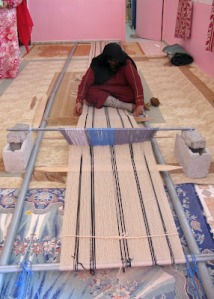
Bhkita with her floor loom
I am not a weaver. When I look at woven textile I look at the colours, the patterns and the texture. I don’t pay much attention to the technicalities of the weaving process. The little bit that I do know about weaving is that the warp yarns are the strong ones which are strung across the loom and keep the textile intact but are usually not visible in the finished product. The weft yarns are softer, thicker and of different colours. They determine the design.
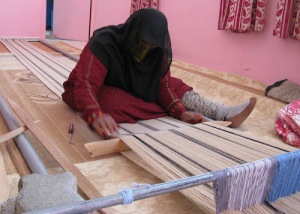
At work
I was therefore quite surprised when I realised that with the floor loom things work the other way around. The warp yarns, strung across the loom in a figure-eight, hold the pattern and the weft yarn provides the strength. Therefore the warp yarns are the coloured ones and are strung onto the loom in a predetermined order. The weaver has to work out the pattern before she sets up the loom. This sounds easy if you have a graph or a pattern to work from, but these women are illiterate. They don’t have paper patterns to work from. It’s all in their head. No wonder Bhkita ‘knows numbers’ – counting is what she does!
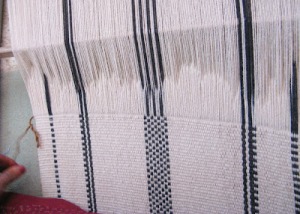
The warp yarns determine the pattern
Bhkita sits on top of the woven part of her textile, facing the heddles. Her hands seems to work effortlessly, but I soon realise weaving on a floor loom is a physical job. She has two sword beaters or el haifs (flat pieces of wood with pointed ends and bevelled edges) set into the warp yarns in different configurations, as determined by her pattern. By turning one of them on the side she opens up the shed and increases the tension at the same time. After she passed the shuttle or el masr (a stick on which the weft yarns has been wound) through, she beats the weft into place with a hook beater. In traditional times this used to be a gazelle horn but now it is an iron hook or a bent screw driver. Beating every row is very important to keep the textile tight and to ensure an even tension throughout.
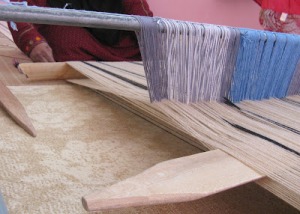
The string heddles and the sword beaters
Bhkita enjoys demonstrating her work to me.
Every now and then she makes sure that I understand everything, that I have good enough photos of every step and whether she can tell me anything more… And if I’m satisfied she carries on talking about her children and their families and about their winter camp-outs in the desert.
She tells me about harvesting desert truffles(“faqah”).
When the desert had good rains in December but stays dry during January, the Bedouins go truffle hunting in March. It’s a treasured delicacy, difficult to find but oh, so delicious to eat.
On our way back to the city I look at the desolate landscape with new eyes. It is still harsh and barren but now I see colour and pattern. And now I know who wants to live here – people who see beauty in the landscape; people who love their children and family. And people who can find truffles in the sand.
*This post first appeared on my personal blog in December 2012
Did you enjoy this post? Share the joy:
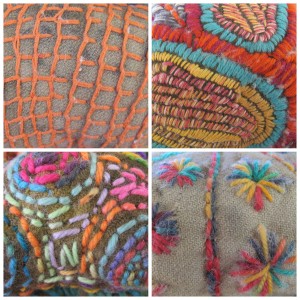 The first time I saw the work of Dulcie Sharp and the other artists of the Yarrenyty Arltere Art Centre was at the Tarnanthi Festival of Contemporary Aboriginal and Torres Strait Islander Art in Adelaide in October last year. Their soft sculptures and hand embroidery jumped out at me. I immediately felt a connection. It is as if every figure had a soul.
The first time I saw the work of Dulcie Sharp and the other artists of the Yarrenyty Arltere Art Centre was at the Tarnanthi Festival of Contemporary Aboriginal and Torres Strait Islander Art in Adelaide in October last year. Their soft sculptures and hand embroidery jumped out at me. I immediately felt a connection. It is as if every figure had a soul.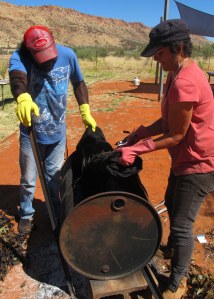 My visit on a perfect autumn day in April could not have happened at a better time! I arrived at the centre on the outskirts of Alice Springs just as a blanket was pulled out of the dye vat. Wool blankets obtained from second-hand shops or donations form the basis for all the soft sculptures. Opening up a newly dyed blanket bundle has everyone in suspense. The rusted metal pieces and the natural plant dyes used in the process ensure that the final product is always an eagerly awaited surprise. This one had subtle green and charcoal patterns which would eventually find their way into another unique artwork.
My visit on a perfect autumn day in April could not have happened at a better time! I arrived at the centre on the outskirts of Alice Springs just as a blanket was pulled out of the dye vat. Wool blankets obtained from second-hand shops or donations form the basis for all the soft sculptures. Opening up a newly dyed blanket bundle has everyone in suspense. The rusted metal pieces and the natural plant dyes used in the process ensure that the final product is always an eagerly awaited surprise. This one had subtle green and charcoal patterns which would eventually find their way into another unique artwork.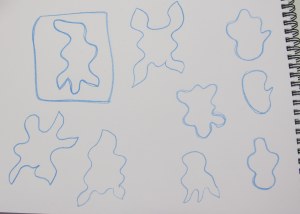 I was fortunate to see the whole artistic process in action. From the newly dyed blankets all the way to the finished sculpture. The artists come up with concepts for their work, usually inspired by their everyday life in the town camps, or their vivid imaginations.
I was fortunate to see the whole artistic process in action. From the newly dyed blankets all the way to the finished sculpture. The artists come up with concepts for their work, usually inspired by their everyday life in the town camps, or their vivid imaginations. 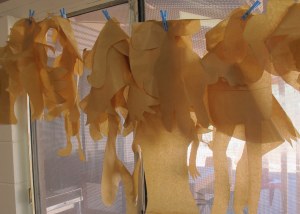
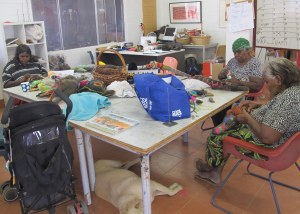 All the work is done at the art centre where the artists come together around a big table piled with yarn and thread in every conceivable colour, texture and thickness. Works in progress and new ideas scribbled on sketchpads find a space on there too. On the day of my visit, I met Rosabella Ryder, Dulcie Sharpe, and Trudy Inkamala. Candy the art centre’s mascot dog kept watch under the table, making sure everyone was happy and safe.
All the work is done at the art centre where the artists come together around a big table piled with yarn and thread in every conceivable colour, texture and thickness. Works in progress and new ideas scribbled on sketchpads find a space on there too. On the day of my visit, I met Rosabella Ryder, Dulcie Sharpe, and Trudy Inkamala. Candy the art centre’s mascot dog kept watch under the table, making sure everyone was happy and safe.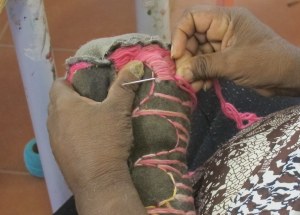 The soft sculptures coming from the hands of these artists, working quietly in this far-flung and remote part of the world, are in high demand in galleries from New York to Singapore. But here around the table, that does not matter. What matters are the stories that are coming to life, stitch by colourful stitch.
The soft sculptures coming from the hands of these artists, working quietly in this far-flung and remote part of the world, are in high demand in galleries from New York to Singapore. But here around the table, that does not matter. What matters are the stories that are coming to life, stitch by colourful stitch.
